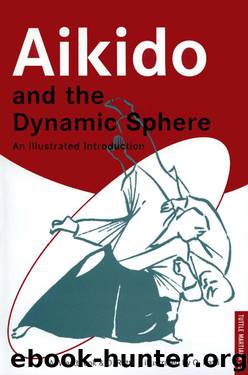Aikido and the Dynamic Sphere: An Illustrated Introduction by Adele Westbrook

Author:Adele Westbrook [Westbrook, Adele]
Language: eng
Format: epub, mobi
Tags: Non-Fiction, Health, Reference
ISBN: 9781462907540
Amazon: B009SC9LGA
Barnesnoble: B009SC9LGA
Goodreads: 17018071
Publisher: Tuttle Publishing
Published: 1989-12-14T23:00:00+00:00
Particular care should also be exercised in the selection of a partner who, as uke, will be the receiver of your technique of neutralization. Ideally, he should have reached your own level of development since that would mean that both of you could practice at a compatible level of coordination.
But this ideal will seldom be possible. Your partner may be an advanced student of the art who will willingly and expertly provide you with the momentum of attack and the aggressive extension you will need to perform the techniques of neutralization successfully. You may then tend to become overconfident and careless about the control of your movements to the extent of actually hurting your partner. Experienced aikido players who really cooperate without "pulling back" are very often subjected to many such painful experiences due to lack of control and discretion on the part of inexperienced nage. Therefore, if an experienced student can get hurt, it is reasonable to assume that an inexperienced student will have still greater chances of being hurt if nage does not exercise caution and control over every stage, every motion, and every action of the strategy of defense.
In accordance with the fundamental principles of aikido practice in relation to combat, i.e., centralized extension of energy and spherical lead, when you secure a hold upon your partner (wrist, elbow, neck, etc.) you should not grip him too tightly, letting your fingers close around and press into his flesh like a vise. Not only is this a poor approach, but closing your fingers completely around any object will automatically close the circuit of your power and return it to you, thus weakening both you and your strategy. You should use your last three fingers (especially your little finger) and your thumb to hold, but your first finger should always be extended or pointing in order to maintain an open circuit of power so that your ki will be flowing outward all the time.
In relation to the techniques of immobilization that you will apply with the cooperation of uke, do not be misled by the feeling of power that may steal over you when you realize how painful they can be if improperly applied. As explained in Chapter IV, pain is only a transitional stage in any aikido technique (especially the immobilizations), not its primary purpose. Pain serves the limited purpose of dissipating the concentrated power of attack of uke by leading its force back to him for a brief moment, i.e., only long enough to lead him into the final immobilization or projection. Inflicting pain for its own sake has always been regarded in aikido (as is true of any superior discipline of development and coordination) as the surest sign of, at best, an immature, incomplete personality; at worst, a degenerate and absolutely negative personality.
In relation to the techniques of projection, do not hang on to uke when projecting him away from you or when bringing him down to the mat because the interruption of his dynamic displacement
Download
Aikido and the Dynamic Sphere: An Illustrated Introduction by Adele Westbrook.mobi
This site does not store any files on its server. We only index and link to content provided by other sites. Please contact the content providers to delete copyright contents if any and email us, we'll remove relevant links or contents immediately.
Shoe Dog by Phil Knight(4893)
The Rules Do Not Apply by Ariel Levy(4526)
Walking by Henry David Thoreau(3685)
Running Barefoot by Amy Harmon(3338)
I'll Give You the Sun by Jandy Nelson(3274)
How to Read Water: Clues and Patterns from Puddles to the Sea (Natural Navigation) by Tristan Gooley(3241)
Crazy Is My Superpower by A.J. Mendez Brooks(3207)
How to Read Nature by Tristan Gooley(3081)
How Music Works by David Byrne(2965)
The Boy, the Mole, the Fox and the Horse by Charlie Mackesy(2829)
The Fight by Norman Mailer(2707)
Seducing Cinderella by Gina L. Maxwell(2545)
Cuba by Lonely Planet(2490)
Accepted by Pat Patterson(2219)
Going Long by Editors of Runner's World(2213)
The Unfettered Mind: Writings from a Zen Master to a Master Swordsman by Takuan Soho(2159)
The Happy Runner by David Roche(2124)
Backpacker the Complete Guide to Backpacking by Backpacker Magazine(2111)
Trail Magic by Trevelyan Quest Edwards & Hazel Edwards(2063)
